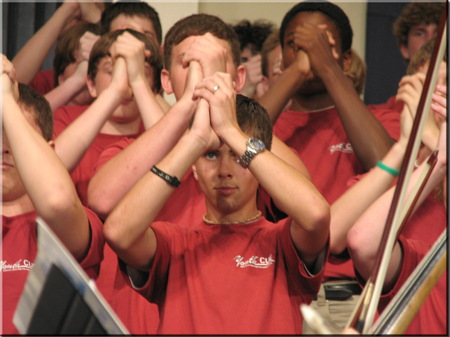Every organization–EVERY one–has to change from time to time. Student choir ministry is no different.
Every organization—EVERY one—has to change from time to time. Student choir ministry is no different.
But how does a director manage change and transition times so as to create the greatest opportunity for growth, both in quality and impact?
I know what you are thinking—this is a HUGE topic and you are going to try to answer that in a blog posting.
It is HUGE, but there are some basics that we can all apply to our situations and we can benefit from the process.
Change Happens!
A few weeks ago a friend posted on Facebook the picture they took of the first leaf that they found that was beginning to change color. The caption read—“Fall is coming!”
My friend who lives in Minnesota posted a reply “Oh NOOOOO!”
But I posted “Bring it ON!”
What was the difference in the responses to a coming change?
My friend hates Minnesota winters and fall means that they are about to return.
I hate Texas summers, and the changing leaf promises me that relief is on the way.
It is the same with you—your view of a needed change in your student choir is often a matter of perspective.
Bottom line—when change is coming embrace the opportunity, no “kicking and screaming” allowed!
Keep the Baby—get rid of the water!
We all know the old adage—throwing the baby out with the bath water.
When change is needed be careful “how much” and “how fast.”
Keep the good stuff. Be honest in your evaluation of exactly what is good and needs to stay—and what desperately needs a make over.
Before making any changes—listen!
I have a trusted group of high school students who meet with me regularly. I ask them questions about choir rehearsal, communication, literature, choir tour details and on and on.
I also have a team of adults who regularly attend rehearsal (to help with music, food, and singing in rehearsal). I meet with them regularly to hear from them on the same subjects.
I give them all space to talk about what they like and what they see needs to change.
Give them permission to be honest. They will love being “heard” and you will benefit from their varied perspectives.
Since I have directed this choir for 33 years, there have been plenty of times when a change was needed.
There have also been times when a simple explanation from you about WHY we do something gives them an “aha” moment. “OK, that makes sense—tell that to the whole choir!”
This year several directors have called and e mailed me to get my advise about some needed changes at their church specifically regarding separating junior high choir from the high school choir and two others about combining (currently) separated choirs.
Divide and Conquer -vs- Combine and Strengthen
There are significant advantages to combining forces (middle school and high school together); and there are significant advantages for creating two choirs.
This posting is not about which is better, but I want to use THIS issue of change to give practical paths to success when a huge change is needed.
If you find yourself needing to combine previously separated choirs, sit down and write out a list of all the advantages to doing that in your situation, also make a list of the challenges that you will face with that from parents, students, church staff, etc.
Communicate either live or in written form, the very best reasons for doing this.
But think of their perspectives, give them the reasons that might include unity within the youth choir, combined leadership, stronger numbers, singing multi-part music, etc.
That is not the time to say, “I am a busy person and I need to have only one rehearsal per week—not two.”
That might be a PART of your decision process, but it is not a part of THEIR perspective of the need for a change.
Advantages for the director, while important and significant, do not need to be in this communication.
What if the opposite is true.
You find yourself ready to shift to two choirs from one.
Emphasize the advantages of a customized rehearsal plan. I manage a junior high choir rehearsal very differently from a high school choir rehearsal.
The choirs sing music that is more closely tailored to their voices and spiritual understanding.
That is a HUGE advantage.
Help parents see the logical progression of maturity—our junior high choir travels only in Texas, the high school choir can go anywhere!
That is a distinction that parents understand. Point that out to them.
Seek Buy-In
BEFORE making any changes ask for support and understanding from all the stake holders—parents, students, staff.
People naturally hate changes that are forced upon them without any chance for input. This is NOT the time to sing, “Trust and Obey.” Instead, a better song is “Say Something!”
Many times when people are walked through the process of your thinking, they will come to the same conclusions that you have come to see.
What happens when they aren’t buying it?
There are times that decisions have to be made that are not popular.
If you have followed these basic principles of change and STILL you have stake holders who are NOT on board—you have some choices.
Delay, but don’t give up!
Press the pause key on the remote.
I had a (liberal) political science professor in college who said, “Conservatives hate everything. . . the first time they hear it!”
Sometimes we need to present the idea for a major change and then put it in a crock pot for some slow cooking.
Pausing a major decision is not a defeat—not at all.
Instead, you may be insuring future success, by allowing the process to move gradually in the hearts and minds of your people.
Avoid the Ditches!
When change is in the air, there are two ditches on each side of the road that you must avoid.
On the one side is changing too much and too quickly.
The other ditch on the other side is recognizing a need for change and trying to cover it up and ignore it—hoping it will go away.
(It won’t.)
Times of transition will happen—guaranteed.
How you respond will determine if the change is healthy and positive, or . . . well. . . . not THAT!
Happy Changing!
Randy Kilpatrick
CueWEB
September 21, 2015









